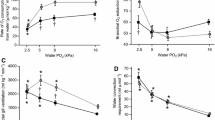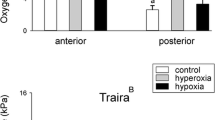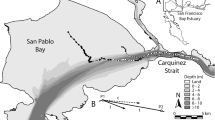Abstract
Though air-breathing has probably evolved mainly as a response to hypoxia, it may provide an important oxygen supplement when metabolism is elevated, as for example during swimming. Due to the increased travelling distance involved when an air-breathing fish swims to and from the surface, and the increased drag when the surface is breached, it can be proposed that air-breathing results in a rise in the apparent cost of transport. In order to investigate this hypothesis, it is necessary to use a fish that is able to swim equally well with and without access to air. The striped catfish Pangasianodon hypophthalmus has been shown to have a sufficiently high capacity for aquatic oxygen uptake in normoxia, to allow for such a comparison. Here, we measured the partitioning of oxygen uptake (\( \dot{M}{\text{O}}_{2} \)) during swimming and recovery, and calculated the apparent cost of transport with and without access to air, under normoxic conditions. Aerial \( \dot{M}{\text{O}}_{2} \) constituted 25–40 % of the total \( \dot{M}{\text{O}}_{2} \) during swimming and less than 15 % during recovery. The net cost of transport was 25 % lower in fish that did not air-breathe compared to fish that did, showing that the cost of surfacing can be substantial. This is the first study to measure partitioning in an air-breathing fish during swimming at velocities close to the critical swimming speed.



Similar content being viewed by others
References
Amin-Naves J, Giusti H, Glass ML (2004) Effects of acute temperature changes on aerial and aquatic gas exchange, pulmonary ventilation and blood gas status in the South American lungfish, Lepidosiren paradoxa. Comp Biochem Phys A 138:133–139
Bell WH, Terhune LDB (1970) Water tunnel design for fisheries research. Fish Res Bd Can Tech Rep 195
Bevan DJ, Kramer DL (1986) The effect of swimming depth on respiratory behavior of the honey gourami, Colisa chuna (Pisces, Belontiidae). Can J Zool 64:1893–1896
Blake RW (1983) Fish locomotion, 1st edn. Cambridge University Press, Cambridge
Brett JR (1965) The relation of size to rate of oxygen consumption and sustained swimming speed of sockeye salmon (Oncorhynchus nerka). J Fish Res Bd Can 22:1491–1501
Brown E, Bruce M, Pether S, Herbert N (2011) Do swimming fish always grow fast? Investigating the magnitude and physiological basis of exercise-induced growth in juvenile New Zealand yellowtail kingfish, Seriola lalandi. Fish Phys Biochem 37:327–336
Burleson ML, Shipman BN, Smatresk NJ (1998) Ventilation and acid-base recovery following exhausting activity in an air-breathing fish. J Exp Biol 201:1359–1368
Cannas M, Schaefer J, Domenici P, Steffensen JF (2006) Gait transition and oxygen consumption in swimming striped surfperch embiotoca lateralis agassiz. J Fish Biol 69:1612–1625
Chapman LJ, Mckenzie DJ (2009) Behavioral responses and ecological consequences. In: Jeffrey GR (ed) Hypoxia fish physiology, vol 27. Academic Press, Dublin, pp 25–77
Claireaux G, Couturier C, Groison AL (2006) Effect of temperature on maximum swimming speed and cost of transport in juvenile European sea bass (Dicentrarchus labrax). J Exp Biol 209:3420–3428
Domenici P, Lefrancois C, Shingles A (2007) Hypoxia and the antipredator behaviours of fishes. Philos Trans R Soc B 362:2105–2121
Farmer CG, Jackson DC (1998) Air-breathing during activity in the fishes Amia calva and Lepisosteus oculatus. J Exp Biol 201:943–948
Farrell AP, Clutterham S (2003) On-line venous oxygen tensions in rainbow trout during graded exercise at two acclimation temperatures. J Exp Biol 206:487–496
Fitzgibbon QP, Strawbridge A, Seymour RS (2007) Metabolic scope, swimming performance and the effects of hypoxia in the mulloway, Argyrosomus japonicus (Pisces: Sciaenidae). Aquaculture 270:358–368
Graham JB, Baird TA (1982) The transition to air breathing in fishes. 1. Environmental-effects on the facultative air breathing of Ancistrus chagresi and Hypostomusplecostomus (Loricariidae). J Exp Biol 96:53–67
Grigg GC (1965) Studies on the Queensland lungfish, Neoceratodus forsteri (Krefft). III. Aerial respiration in relation to habits. Aust J Zool 13:413–421
Hedrick MS, Jones DR (1999) Control of gill ventilation and air-breathing in the bowfin Amia calva. J Exp Biol 202:87–94
Hedrick MS, Katz SL, Jones DR (1994) Periodic air-breathing behavior in a primitive fish revealed by spectral-analysis. J Exp Biol 197:429–436
Iftikar FI, Patel M, Ip YK, Wood CM (2008) The influence of feeding on aerial and aquatic oxygen consumption, nitrogenous waste excretion, and metabolic fuel usage in the African lungfish, Protopterus annectens. Can J Zool 86:790–800
Kramer DL (1983) The evolutionary ecology of respiratory mode in fishes—an analysis based on the costs of breathing. Environ Biol Fish 9:145–158
Kramer DL, Mcclure M (1981) The transit cost of aerial respiration in the catfish Corydoras aeneus (Callichthyidae). Physiol Zool 54:189–194
Lefevre S, Huong DTT, Wang T, Phuong NT, Bayley M (2011a) Hypoxia tolerance and partitioning of bimodal respiration in the striped catfish (Pangasianodon hypophthalmus). Comp Biochem Phys A 158:207–214
Lefevre S, Jensen FB, Huong D, Wang T, Phuong NT, Bayley M (2011b) Effects of nitrite exposure on functional haemoglobin levels, bimodal respiration, and swimming performance in the facultative air-breathing fish Pangasianodon hypophthalmus. Aqua Toxicol 104:86–93
Luna-Acosta A, Lefrantois C, Millot S, Chatain B, Bqgout ML (2011) Physiological response in different strains of sea bass (Dicentrarchus labrax): swimming and aerobic metabolic capacities. Aquaculture 317:162–167
McKenzie DJ, Steffensen JF, Taylor EW, Abe AS (2012) The contribution of air-breathing to aerobic scope and exercise performance in the banded knifefish Gymnotus carapo L. J Exp Biol 215:1323–1330
Milsom WK (2002) Phylogeny of CO2/H+ chemoreception in vertebrates. Respir Physiol Neurobiol 131:29–41
Rahn H, Rahn KB, Gans C, Howell BJ, Tenney SM (1971) Air breathing of garfish (Lepisosteus osseus). Resp Phys 11:285–307
Sanchez AP, Hoffmann A, Rantin FT, Glass ML (2001) Relationship between cerebro-spinal fluid pH and pulmonary ventilation of the South American lungfish, Lepidosiren paradoxa (Fitz). J Exp Zool 290:421–425
Seymour RS, Christian K, Bennett MB, Baldwin J, Wells RMG, Baudinette RV (2004) Partitioning of respiration between the gills and air-breathing organ in response to aquatic hypoxia and exercise in the Pacific tarpon, Megalops cyprinoides. Physiol Biochem Zool 77:760–767
Shelton G, Jones DR, Milsom WK (1986) Control of breathing in ectothermic vertebrates. In: Handbook of physiology—the respiratory system II. Physiological Society, Bethesda, pp 857–909
Shingles A, McKenzie DJ, Claireaux G, Domenici P (2005) Reflex cardioventilatory responses to hypoxia in the flathead gray mullet (Mugil cephalus) and their behavioral modulation by perceived threat of predation and water turbidity. Physiol Biochem Zool 78:744–755
So N, Van Houdt JKJ, Volckaert FAM (2006) Genetic diversity and population history of the migratory catfishes Pangasianodon hypophthalmus and Pangasius bocourti in the Cambodian Mekong River. Fish Sci 72:469–476
Stevens ED, Randall DJ (1967) Changes in blood pressure, heart rate and breathing rate during moderate swimming activity in rainbow trout. J Exp Biol 46:307–315
Sundin L, Nilsson S (2002) Branchial innervation. J Exp Zool 293:232–248
Sundin L, Reid SG, Rantin FT, Milsom WK (2000) Branchial receptors and cardiorespiratory reflexes in a neotropical fish, the tambaqui (Colossoma macropomum). J Exp Biol 203:1225–1239
Takeda T, Ishimatsu A, Oikawa S, Kanda T, Hishida Y, Khoo KH (1999) Mudskipper Periophthalmodon schlosseri can repay oxygen debts in air but not in water. J Exp Zool 284:265–270
Wells RMG, Baldwin J, Seymour RS, Christian KA, Farrell AP (2007) Air breathing minimizes post-exercise lactate load in the tropical Pacific tarpon, Megalops cyprinoides Broussonet 1782 but oxygen debt is repaid by aquatic breathing. J Fish Biol 71:1649–1661
Wilson RJ, Harris MB, Remmers JE, Perry SF (2000) Evolution of air-breathing and central CO2/H+ respiratory chemosensitivity: new insights from an old fish? J Exp Biol 203:3505–3512
Acknowledgments
This study was performed at Can Tho University (Vietnam) and was supported by Danida [(Danida Fellowship Centre, Denmark (Grant numbers 84-08-AU, 207-AU)], the Danish Research Council, and the Faculty of Science and Technology at Aarhus University.
Author information
Authors and Affiliations
Corresponding author
Additional information
Communicated by G. Heldmaier.
Rights and permissions
About this article
Cite this article
Lefevre, S., Wang, T., Huong, D.T.T. et al. Partitioning of oxygen uptake and cost of surfacing during swimming in the air-breathing catfish Pangasianodon hypophthalmus . J Comp Physiol B 183, 215–221 (2013). https://doi.org/10.1007/s00360-012-0701-8
Received:
Revised:
Accepted:
Published:
Issue Date:
DOI: https://doi.org/10.1007/s00360-012-0701-8




